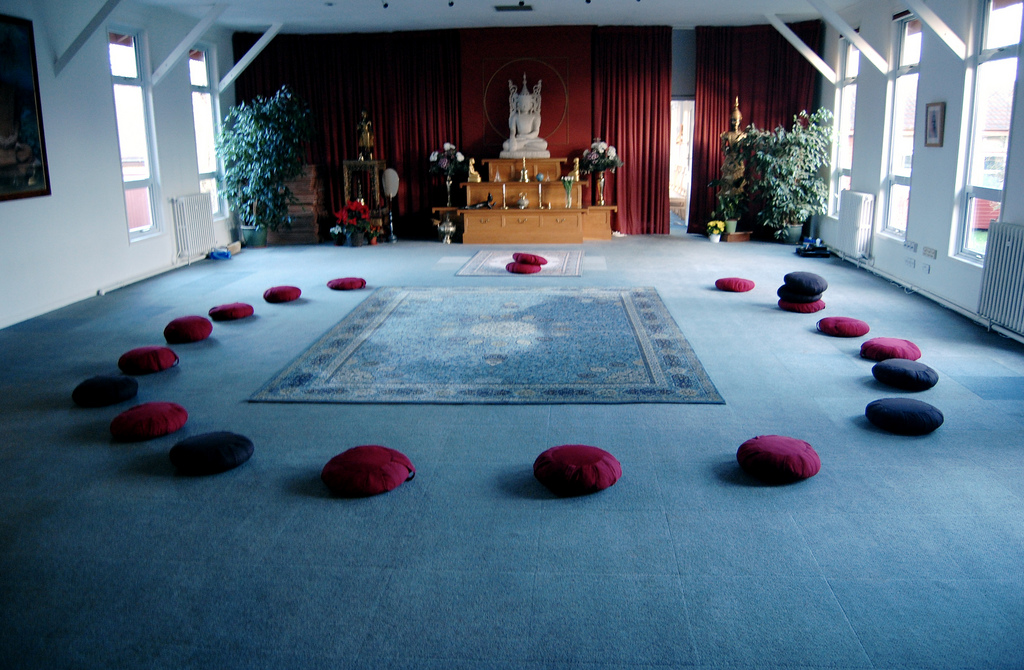|
Aruna Ratanagiri
Aruna Ratanagiri Buddhist Monastery (Harnham Buddhist Monastery) is a Theravada Buddhist monastery of the Thai Forest Tradition in Northumberland, England. The community consists of monks, novices and postulants from a wide range of nationalities, usually numbering around eight Sangha members. The monastery includes an adjacent lay retreat facility known as ''Kusala House''. History The monastery was founded in response to increasing interest, particularly in northeast England, in the Thai Forest Tradition, as it was being established by Ajahn Sumedho and other disciples of Ajahn Chah in England in the late 1970s. When, in 1980, a group of local yoga students tried to find a suitable cottage which they could offer as a retreat facility to the Sangha, farmer John Wake of Harnham Hall, Harnham, near Belsay responded, and they agreed to rent one of his farm cottages. In 1981 Ajahn Sucitto (the abbot of Cittaviveka/ Chithurst Buddhist Monastery 1992–2014) became the first bhikkhu t ... [...More Info...] [...Related Items...] OR: [Wikipedia] [Google] [Baidu] |
Thai Forest Tradition
The Kammaṭṭhāna Forest Tradition of Thailand (from pi, kammaṭṭhāna meaning Kammaṭṭhāna, "place of work"), commonly known in the West as the Thai Forest Tradition, is a Parampara, lineage of Theravada Buddhist monasticism. The Thai Forest Tradition started around 1900 with Ajahn Mun Bhuridatto, who wanted to practice Buddhist monasticism, and its meditative practices, according to the normative standards of pre-sectarian Buddhism. After studying with Ajahn Sao Kantasīlo and wandering through the north-east of Thailand, Ajahn Mun reportedly became a Anāgāmi, non-returner and started to teach in North-East Thailand. He strived for a revival of the Pre-sectarian Buddhism, Early Buddhism, insisting on a strict observance of the Buddhist monastic code, known as the Vinaya, and teaching the practice of ''jhāna'' and the realisation of ''nibbāna''. Initially, Ajahn Mun's teachings were met with fierce opposition, but in the 1930s his group was acknowledged as a f ... [...More Info...] [...Related Items...] OR: [Wikipedia] [Google] [Baidu] |
Dhamma Hall
Dharma (; sa, धर्म, dharma, ; pi, dhamma, italic=yes) is a key concept with multiple meanings in Indian religions, such as Hinduism, Buddhism, Jainism, Sikhism and others. Although there is no direct single-word translation for ''dharma'' in European languages, it is commonly translated as "righteousness", "merit" or "religious and moral duties" governing individual conduct.Britannica, The Editors of Encyclopaedia. (9 April 2019)Dharma. ''Encyclopedia Britannica''. Accessed 14 September 2021. In Hinduism, dharma is one of the four components of the ''Puruṣārtha'', the aims of life, and signifies behaviours that are considered to be in accord with ''Ṛta'', the order that makes life and universe possible. It includes duties, rights, laws, conduct, virtues and "right way of living".see: *"Dharma", ''The Columbia Encyclopedia'', 6th Ed. (2013), Columbia University Press, Gale, ; *Steven Rosen (2006), Essential Hinduism, Praeger, , Chapter 3. It had a transtemporal ... [...More Info...] [...Related Items...] OR: [Wikipedia] [Google] [Baidu] |
Amaravati Buddhist Monastery
Amaravati is a Theravada Buddhist monastery at the eastern end of the Chiltern Hills in South East England. Established in 1984 by Ajahn Sumedho as an extension of Chithurst Buddhist Monastery, the monastery has its roots in the Thai Forest Tradition. It takes inspiration from the teachings of the community's founder, the late Ajahn Chah. Its chief priorities are the training and support of a resident monastic community, and the facilitation for monastic and lay people alike of the practice of the Buddha's teachings. It is not to be confused with the ancient Amaravati Stupa in India. Community The resident community consists of monks (bhikkhus), nuns ( siladhara), and male and female postulants who live in accordance with strict traditional codes of celibacy, together with a volunteer support staff and visitors. According to the monastery website, regarding the male monastic community, "Usually, there are between 15 and 25 bhikkhus and samaneras in residence, living a conte ... [...More Info...] [...Related Items...] OR: [Wikipedia] [Google] [Baidu] |
Wat Pah Nanachat
Wat Pah Nanachat ( th, วัดป่านานาชาติ; ''Bung Wai International Forest Monastery'') is a Thai Theravada Buddhist monastery in northeast Thailand about 15 kilometres from the city of Ubon Rachathani. It was established in 1975 by Ajahn Chah as a training community for non-Thais according to the norms of the Thai Forest Tradition. Resident monks, novices and postulants include a wide range of nationalities. The primary language of communication and instruction is English. History The monastery was founded in response to increasing international interest, particularly from the United Kingdom, in the Theravadin forest tradition of Thailand. The first abbot of Wat Pah Nanachat was Ajahn Sumedho, an American bhikkhu trained by Ajahn Chah at Wat Nong Pah Pong, the motherhouse of Wat Pah Nanachat. Today, as a consequence, students of the Thai forest tradition are found in branch monasteries around the world under the collective label of ''The Forest Sangha ... [...More Info...] [...Related Items...] OR: [Wikipedia] [Google] [Baidu] |
Wat Nong Pah Pong
''Wat Nong Pah Pong'' (Generally shortened to: ''Wat Pah Pong'', Thai: วัดหนองป่าพง) is a Theravada Buddhist monastery in Ubon Ratchathani Province, (Amphoe) Warin Chamrap, Thailand. It was established by the late Ajahn Chah as the main monastery of the Thai Forest Tradition. International Branch Monasteries In 1975, one of Ajahn Chah's first Western disciples, the Venerable Ajahn Sumedho, opened what was to be the first in a long line of branch monasteries (currently around 240 branches) of '' Wat Pah Pong'' specifically geared towards the growing interest in traditional Buddhist practices among Westerners. The Thai monastery '' Wat Pah Nanachat'', along with a growing list of monasteries, opened in recent years around the world, are introducing the heart of the Buddhist teachings to what was previously something of an inaccessible audience to the Thai Forest masters. Following is an incomplete list of International branch monasteries and associated mon ... [...More Info...] [...Related Items...] OR: [Wikipedia] [Google] [Baidu] |
Ajahn Viradhammo
Ajahn Viradhammo or Luang Por Viradhammo (born Vitauts Akers, April 27, 1947 Esslingen, Germany) is a Canadian monk in the Thai forest tradition of Theravada Buddhism. He was ordained as a monk in 1974 by Ajahn Chah at Wat Nong Pah Pong monastery and became one of the first residents at Wat Pah Nanachat, the international monastery in north-east Thailand. Luang Por Viradhammo is the most senior Thai Forest monk in Canada and currently the Abbot of Tisarana Buddhist Monastery in Perth, Ontario. ''Luang Por'' means ''Venerable Father'' (หลวงพ่อ), an honorific and term of affection in keeping with Thai custom; ''ajahn'' means ''teacher''. Biography Ajahn Viradhammo was born Vitauts Akers in a displaced persons camp in Esslingen, Germany where his parents had become refugees after fleeing from the Soviet re-occupation of Latvia in 1944. He, his parents and two year older brother immigrated to Toronto, Canada in 1951. Ajahn Viradhammo's parents were both Luthera ... [...More Info...] [...Related Items...] OR: [Wikipedia] [Google] [Baidu] |
Ajahn Amaro
Ajahn Amaro (born 1956) is a Theravāda Buddhist monk and teacher, and abbot of the Amaravati Buddhist Monastery at the eastern end of the Chiltern Hills in South East England. The centre, in practice as much for ordinary people as for monastics, is inspired by the Thai Forest Tradition and the teachings of the late Ajahn Chah. Its chief priorities are the practice and teaching of Buddhist ethics, together with traditional concentration and insight meditation techniques, as an effective way of dissolving suffering. Biography Ajahn Amaro was born J. C. Horner in Kent. He was educated at Sutton Valence School and Bedford College, University of London. ''Ajahn'' means ''teacher''. He is a second cousin of I.B. Horner (1896–1981), late President of the Pali Text Society. Apart from a certain interest in the theories of Rudolf Steiner—to which he had been introduced by Trevor Ravenscroft, Amaro's principal enthusiasms on leaving university were, by his own admission, pretty m ... [...More Info...] [...Related Items...] OR: [Wikipedia] [Google] [Baidu] |
Chah Subhatto
Chah Subhaddo ( th, ชา สุภัทโท, known in English as Ajahn Chah, occasionally with honorific titles ''Luang Por'' and ''Phra'') also known by his honorific name "Phra Bodhiñāṇathera" ( th, พระโพธิญาณเถร, Chao Khun Bodhinyana Thera; 17 June 1918 – 16 January 1992) was a Thai Buddhist monk. He was an influential teacher of the ''Buddhadhamma'' and a founder of two major monasteries in the Thai Forest Tradition. Respected and loved in his own country as a man of great wisdom, he was also instrumental in establishing Theravada Buddhism in the West. Beginning in 1979 with the founding of ''Cittaviveka'' (commonly known as Chithurst Buddhist Monastery) in the United Kingdom, the Forest Tradition of Ajahn Chah has spread throughout Europe, the United States and the British Commonwealth. The dhamma talks of Ajahn Chah have been recorded, transcribed and translated into several languages. More than one million people, including the Th ... [...More Info...] [...Related Items...] OR: [Wikipedia] [Google] [Baidu] |
Forest Tradition Of Ajahn Chah
The Forest Tradition of Ajahn Chah is a Mahanikai monastic organization in the Thai Forest Tradition composed of the students of Ajahn Chah Subhaddo. Strictly speaking, the ''Forest Tradition of Ajahn Chah'' denotes the institutions who have a branch affiliation with Wat Pah Pong, the administrative center of the organization. History Ajahn Chah's early training Ajahn Jayasāro relates that while many Mahanikai monks would reordain in the Dhammayut order as an act of devotion to Ajahn Mun, a handful of other followers of Ajahn Mun would choose to stay Mahanikai monks. Luang Por Thongrat Ajahn Jayasaro relates that Ajahn Thongrat was considered "Zen Like", in the sense that he was very "Vigorous and outspoken — and outrageous — in his behaviour. Which of course in Thai monastic idiom, where etiquette and good behavior is so stressed, it quite made him stand out." Little is known of Ajahn Chah's relationship with Ajahn Thongrat, though Ajahn Chah relates a story about ... [...More Info...] [...Related Items...] OR: [Wikipedia] [Google] [Baidu] |
Scotland
Scotland (, ) is a country that is part of the United Kingdom. Covering the northern third of the island of Great Britain, mainland Scotland has a border with England to the southeast and is otherwise surrounded by the Atlantic Ocean to the north and west, the North Sea to the northeast and east, and the Irish Sea to the south. It also contains more than 790 islands, principally in the archipelagos of the Hebrides and the Northern Isles. Most of the population, including the capital Edinburgh, is concentrated in the Central Belt—the plain between the Scottish Highlands and the Southern Uplands—in the Scottish Lowlands. Scotland is divided into 32 administrative subdivisions or local authorities, known as council areas. Glasgow City is the largest council area in terms of population, with Highland being the largest in terms of area. Limited self-governing power, covering matters such as education, social services and roads and transportation, is devolved from the Scott ... [...More Info...] [...Related Items...] OR: [Wikipedia] [Google] [Baidu] |
Retreat (spiritual)
The meaning of a spiritual retreat can be different for different religious communities. Spiritual retreats are an integral part of many Hindu, Jewish, Buddhist, Christian and Sufi communities. In Hinduism and Buddhism, meditative retreats are seen by some as an intimate way of deepening powers of concentration and insight. Retreats are also popular in Christian churches, and were established in today's form by St. Ignatius of Loyola (14911556), in his Spiritual Exercises. Ignatius was later to be made patron saint of spiritual retreats by Pope Pius XI in 1922. Many Protestants, Catholics and Orthodox Christians partake in and organize spiritual retreats each year. Meditative retreats are an important practice in Sufism, the mystical path of Islam. The Sufi teacher Ibn Arabi's book ''Journey to the Lord of Power (Risālat al-Anwār)'' is a guide to the inner journey that was published over 700 years ago. Buddhism A retreat can either be a time of solitude or a commun ... [...More Info...] [...Related Items...] OR: [Wikipedia] [Google] [Baidu] |







